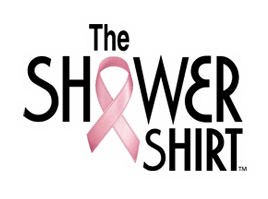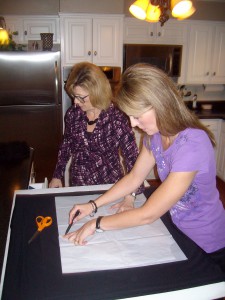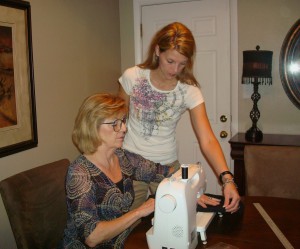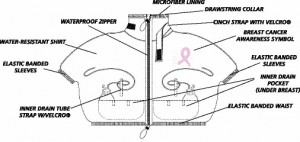Blog
The Role of the Caregiver
Before continuing my ‘To Blog or Not to Blog’ series, I want to take the opportunity to discuss the difficult role of the cancer patient caregiver. I’ve discussed the myriad of difficulties of being the patient, but haven’t necessarily approached the other side of the equation, the ‘caregiver.’
A few weeks into my Blogging series, a gentleman by the name of Cameron Von St. James forwarded a message about his journey as a caregiver to his wife; Heather, a mesothelioma patient. Cameron requested I share his story about the importance of the caregiver support role as it relates to the healing process of the patient. See you next week.
Lisa F. Crites, The SHOWER SHIRT Principal/Inventor
My Difficult Journey as a Cancer Caregiver
When my wife was diagnosed with mesothelioma, she would frequently tell me how she couldn’t imagine what I was going through as a caregiver and a husband. I seldom spoke at length about it with her, but I hope to share more now for the benefit of those families currently struggling through a battle with cancer.
Sometimes great happiness and joy can be accompanied by great sorrow. In our case, we were blessed with our baby girl Lily. Three months later, my wife received the news of her condition. Our world came crashing down in a matter of seconds, when the doctor spoke the word “mesothelioma.” I looked towards my wife at the sound of those words and wondered to myself how we would ever get through this.
Naturally I felt helpless, that there was nothing I could do. The doctor began to consult us about the different options that were available to us, suddenly I realized that this was really happening and it wasn’t going to stop because my wife and I were heartbroken. A long road was ahead for the two of us, and despite the grief we would need to fight through it.
I was consumed by rage soon afterwards, wondering why this was happening during what should have been the happiest times of our lives. Often I resorted to profanity as a terrible means of expression. In due time I calmed down and came to my senses, my wife would need me now more than ever. I had to be strong for her even when I didn’t understand. She needed stability and someone to make her happy despite the circumstances. The task was daunting, but from then on I always did my best to be a stable source of hope and optimism throughout her battle.
 Heather, Lily and Cameron
Heather, Lily and Cameron
Soon I was juggling appointments, work-schedules, and raising our daughter. I got the hang of it soon enough. After my pride subsided, I realized there was an entire support network that was waiting to help. Not for lack of effort, at times I still managed to feel overwhelmed with the massive amount of responsibility I had inherited. However, with the wonderful support of our loving family and friends, I was able to stay sane.
While my wife underwent mesothelioma surgery in Boston, we sent our baby girl to stay with her grandparents in South Dakota. As soon as Heather was healthy enough to travel, she joined Lily at her parent’s house, while I returned home to work. Unfortunately, over the next two months I would be able to see my family only one time. It was excruciatingly difficult to be away from the ones I loved, but it was a necessary decision in the face of extreme adversity. We simply saw the choice as a sign that some of this was still in our control and we weren’t yet ready to give up.
My wife was diagnosed over seven years ago, and despite the overwhelming odds, her treatment and our persistence paid off. She is cancer free to this day. I hope others who are unfortunately reliving this tale in their own lives will find strength in our story to help them carry on. For more information on mesothelioma or asbestos, check out the links below.
http://www.mesothelioma.com/mesothelioma/
http://www.mesothelioma.com/asbestos-exposure/
Cameron Von St. James
Gathering Opinions & Minimal Market Surveys
 With my Shower Jacket prototype in hand, I began meeting with whomever I could who might have insight into what I was supposed to do next. I spoke with my CEO, Mr. Emil Miller, and the CFO, Mr. George Fayer, who were at the helm of Wuesthoff Health System, the organization I was employed by as a media strategist and new business development director.
With my Shower Jacket prototype in hand, I began meeting with whomever I could who might have insight into what I was supposed to do next. I spoke with my CEO, Mr. Emil Miller, and the CFO, Mr. George Fayer, who were at the helm of Wuesthoff Health System, the organization I was employed by as a media strategist and new business development director.
I thought maybe, since both had worked in corporate healthcare administration for many years, they might have insight into what I was trying to create, as well as the businesses of Home Medical Equipment (HME) and Durable Medical Equipment (DME) companies. I felt the product could be perfect for various healthcare retail locations, but wanted to hear opinions from experienced healthcare executives.
I had worked with both gentlemen for four years, and had a great working relationship; of course, during those years, we had a myriad of arguments on media strategy in terms of what ‘to say,’ versus what ‘not to say’ to the media, but we co-existed very well, and absolutely respected their opinions when it came to my idea.
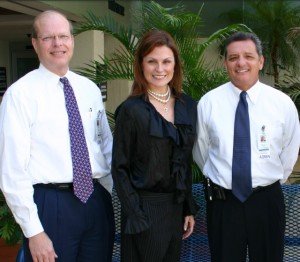 Emil Miller, George Fayer and Myself
Emil Miller, George Fayer and Myself
I was pleasantly surprised by both of their positive responses. It’s because of Mr. Miller’s insight we eventually changed the title of the product from ‘Shower Jacket,’ to ‘Shower Shirt.’ All I needed to hear Mr. Fayer say was, “With the trend of expanding women’s services, I could definitely see us purchasing a product like this for our HME locations.” With that said, and mind you, CFO’s are extremely tight with the purse strings, I thought I might be onto something. If I could get Wuesthoff’s (very conservative) CFO to make positive comments about the usefulness of this creation and the interest in purchasing, I felt other hospitals, mastectomy boutiques, and HME/DME organizations might follow suit.
But first, I had to find a manufacturer! In doing so, I reached out to a friend who had a friend that imported/exported automobile parts. His name is Mike, but I have now named him my Chinese liaison, though he’s not Chinese. Whoops! Did I say Chinese? Yes, we reluctantly had the product manufactured in China as all American manufacturers had estimated charges of nearly $80.00 per unit, the same price range we were looking to charge retail. Before this process, I often wondered why companies contracted overseas manufacturing instead of having products created in the United States. Now, I understand why, if this specific product was required to be created domestically, it would have never gone on the market as the American estimate priced it out of the market.
I met with Mike and he said he believed he could get the water resistant manufactured through his overseas contacts, and based on the initial drawings and conversation with the Chinese; we were possibly looking at 70% less than the American estimate. Our prototype was then shipped out for review and we waited for a response.
Stay Tuned,
Lisa F. Crites
The Shower Shirt Co., Founder/Inventor
Health/Medical Print Journalist & Guest Columnist
The Prototype Creation
 So I had the architectural design of what I was calling the “Shower Jacket” on paper. I phoned my Aunt Marianne and Cousin Mandy, and asked if they would create a prototype of the shower jacket based on my brothers drawing. They of course said “yes,” as they knew it would be a bit difficult to tell me “no” :).
So I had the architectural design of what I was calling the “Shower Jacket” on paper. I phoned my Aunt Marianne and Cousin Mandy, and asked if they would create a prototype of the shower jacket based on my brothers drawing. They of course said “yes,” as they knew it would be a bit difficult to tell me “no” :).
They first created a sewing pattern based on the drawing, and then utilized a beauty salon cape for the actual prototype, while adding the internal straps and pockets as reflected in the design. Seeing that I’m not a seamstress, and do not understand the theory behind the mechanics of sewing, I was amazed to actually see a product come to life based on a drawing. I guess no different than a home coming to life based on architectural home design plans; though in my mind, this seemed different. Homes have been constructed for many, many years, all shapes, sizes, and dimensions. Though having undertaken the many water-resistant garment searches on my own over the past several months, and patent searches with my attorney, I knew this was going to be the only ‘shower jacket’ in existence, thus, quite unique in my mind.
My Aunt Marianne & Cousin Mandy
Within a couple of weeks I had the first shower jacket prototype. I say the first as we theoretically updated five variations before deciding on the final product more than a year later.
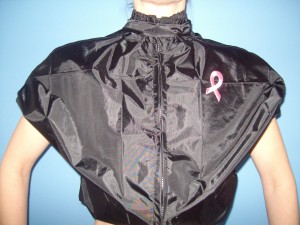 Initial “Shower Jacket” Prototype
Initial “Shower Jacket” Prototype
As you can imagine, I was feeling (and still do) extremely blessed to have family members who were willing to help me in the initial stages of this process. Because of their talents, I was not required to hire a design company for the creative work, nor a manufacturing group to create the prototype. I was still on disability, totally unaware of the costs of medical bills which had already incurred, and what my future held in terms of additional surgeries and costs, therefore, I needed to keep all financials related to this initiative at a minimum. Plus, I was hoping to do the entire project on my own, without any financial help.
So I now had an official prototype of my creation; a shower jacket made from a beauty salon cape. I had to again, essentially ask myself the same question my brother, Charles, had previously asked me, “What the hell am I supposed to do with this?”
Stay Tuned,
Lisa F. Crites
The Shower Shirt Co., Founder/Patented Inventor
Health/Medical Print Journalist & Guest Columnist
Trying to Get Back to Normal & The ‘Big Idea’
 The drama was finally over (or so I thought) in terms of unexpected surprises relating to my breast cancer diagnosis, infections and pathology reports. I wanted to get back to my life, my work, and my relationship. I was gravely needing some hint of normalcy (whatever normal is for a Crites).
The drama was finally over (or so I thought) in terms of unexpected surprises relating to my breast cancer diagnosis, infections and pathology reports. I wanted to get back to my life, my work, and my relationship. I was gravely needing some hint of normalcy (whatever normal is for a Crites).
I still was exhausted from the infection so I maintained my two, four hour, naps per day. During the limited hours in which I was vertical each day, I began focusing on the creation of s water-resistant garment for showering purposes. I had an extremely basic idea for the design, and knew I wanted to create a quality product with a type of water-resistant parachute material. I also knew the chest area had to be created with sensitivity to the drain regions, but otherwise, I had not thought through the overall creative work of the design.
I was at dinner one evening and began drawing a bolero-style jacket on my napkin. I included all of the bells and whistles needed on the inside of the garment to both protect the post-surgical drains from becoming wet, while also hosting the weight of the drains. I knew women varied in all shapes and sizes so I was going to need to create an elastic perimeter. It was also a given that the most important feature of the product was the neck region; if the neck wasn’t covered appropriately and completely “over-engineered,” as my significant other infers, the product could fail.
Since this was not the first time I had started a project in which I didn’t know what I was doing, I totally relied on blind faith. Of course blind faith, and my calming head-voice who I could still hear saying, “Create a water-resistant product for surgery patients, create a water-resistant product for surgery patients.”
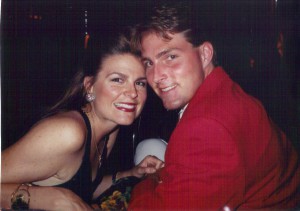 My Younger Brother, Charles & I
My Younger Brother, Charles & I
After completing my quite awkward looking bolero jacket drawing, I sent it to my younger brother, Charles. He called me and said, “What the hell am I supposed to do with this?” I requested he transform my drawing into some type of a shower jacket. He’s somewhat of an architect; though he says he’s an engineer. But since he draws and designs buildings, I felt highly confident he could draw and design a garment for showering.
After a bit of complaining from him, and conversations back and forth, he created the drawing below. Tears came to my eyes up when I saw it; he did a fantastic job on the execution I wanted in terms of the design. Though the version I have included below is only a portion of the final architectural schematic, it gives the overall basics, and a fantastic image of what I needed for prototyping purposes. I was excited my idea was now on paper. Though I had to ask myself what Charles had previous asked me, “What the hell am I supposed to do with this?”
Stay Tuned,
Lisa F. Crites
The Shower Shirt Co., Founder/Inventor
Health /Medical Print Journalist & Guest Columnist
Breast Cancer In The Second Breast?
 Hearing Dr. O’Linde say, “The lobular carcinoma in situ would have eventually shown up on the mammogram,” just wasn’t precise enough information for me to be content. Being a past Health/Medical television reporter, I enjoyed digging into medical stories to better understand the diagnosis, the prognosis, and the ultimate outcome. This was no different. I needed to better understand how there could have been diseased tissue in my ‘healthy breast’ my physicians didn’t know about, and more importantly, what could have happened if I had not chosen to have a bi-lateral mastectomy.
Hearing Dr. O’Linde say, “The lobular carcinoma in situ would have eventually shown up on the mammogram,” just wasn’t precise enough information for me to be content. Being a past Health/Medical television reporter, I enjoyed digging into medical stories to better understand the diagnosis, the prognosis, and the ultimate outcome. This was no different. I needed to better understand how there could have been diseased tissue in my ‘healthy breast’ my physicians didn’t know about, and more importantly, what could have happened if I had not chosen to have a bi-lateral mastectomy.
You might say, “Why the need to know, it’s already gone?” You are correct, and I realize the ‘need to know’ and understand factor is not necessarily a good trait, especially when ‘my need to know more’ was only going to further upset me.
I began doing research and found Lobular Carcinoma in Situ (LCIS) is an uncommon condition in which abnormal cells form in the lobules of the breast; being diagnosed with LCIS indicated I had an increased risk of developing breast cancer in that breast as well. More importantly, women with LCIS have an increased risk of developing ‘invasive breast cancer.’
Invasive Breast Cancer? Now this was upsetting. Remember, I had choices with my initial breast cancer. I was lucky it was Stage 1 and caught early. As odd as it was, and though both breasts had been removed, I was extremely upset I had pre-cancerous tissue (in the left breast) which could have caused an invasive form of breast cancer. With that, I might not have had choices in my clinical treatment; I may have been required to undergo chemotherapy, something which would not have been psychologically acceptable to me.
I cried more over this recent revelation of information than I did when I was diagnosed with breast cancer in the first place. Most individuals would enjoy having a crystal ball to see what the future held; however, this peek into the future was a bit traumatizing. I found myself talking about these findings repeatedly, to whomever of my friends and family would listen. 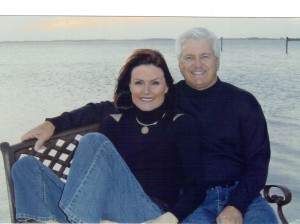 David (aka: Phil) & Lisa
David (aka: Phil) & Lisa
My significant other, Phil, kept saying, “Lisa, the tissue is gone, why are you so upset?” I couldn’t answer that question; and to this day, I still can’t explain why I was so affected by the findings of that report. It absolutely overwhelmed me to think if I had not chosen to have a bi-lateral mastectomy, I would have been diagnosed with breast cancer again and the second diagnosis would have obviously been far worse than the first.
As I said in my previous Blog, despite complications, I would not change the decisions I’ve made in terms of my breast cancer treatment. In the end, the primary reason for being upset was the exact reason I chose to take a more aggressive approach to this diagnosis; and the decision to remove both breasts versus only the cancerous one.
In this case, my decision which was ultimately based on fear actually paid off. Despite the emotional roller-coaster, despite the infection and myriad of tears, I knew I had made the right decision!!!
Stay tuned,
Lisa F. Crites
The Shower Shirt Co., Founder/Inventor
Health/Medical Print Journalist & Guest Columnist
Discharged From The Hospital
 My last Blog was extremely revealing; emotionally, psychologically, and obviously visually. I thought long and hard about sharing those photos, and hope I did not negatively affect anyone’s decision whether or not to undergo mastectomy surgery, if needed.
My last Blog was extremely revealing; emotionally, psychologically, and obviously visually. I thought long and hard about sharing those photos, and hope I did not negatively affect anyone’s decision whether or not to undergo mastectomy surgery, if needed.
I want to start this Blog by first saying I would make the same decisions all over again, even though my issues with surgical infections did not stop at that first infection. I had more, and will explain those encounters soon. However, even given the complications, I would again choose to have a bi-lateral mastectomy because that ‘course of action’ was psychologically acceptable to me, and for the first time in my life, through science, I was able to actually see what the future would have held. (You will understand that statement in my next Blog.)
I hope the fear of an infection will not keep breast cancer patients from considering the mastectomy route. As written previously, the American Hospital Association states five-percent of all breast cancer surgery patients endure infections of one type or another. I can’t say if this is higher or lower than infection rates of other surgeries, but it stands to reason all surgeries have the chance for infections and complications.
But back to my story, after 48 hours of convalescing in the hospital following the removal of the infected tissue expander, I was discharged. That infection absolutely sucked the life out of me, for the first time in my 42 years I had no energy. I would get up in the morning, have breakfast and go back to bed; up for lunch and back to bed; and normally did not eat dinner.
I was still on leave from work, with little to do except recover from these two major surgeries. I kept thinking about showering with that darn trash bag, how difficult it was, and what it would take to create something which would work for my situation, as well as fellow mastectomy patients.
Before I was really able to focus on that project, I had an appointment with Dr. O’Linde, the wonderful surgeon who performed my mastectomy. Since this was only the first time I had seen him post-infection, we reviewed the results of my pathology report from the mastectomy surgery. The breast cancer had been diagnosed in my right breast only, however, after reading through the pathology report, it was obvious something was also problematic with my left breast.
The discussion during my appointment went like this: “Dr. O’Linde, per my pathology report, it says I have atypical lobular carcinoma in situ in my left breast. What does that mean?”
He said, “Yes, that’s something that would have eventually shown up on your mammogram.”
What? Something that would have shown up on my mammogram, when? He didn’t seem to want to discuss as it was technically a moot point since the left breast had been removed. I pushed a bit further but got no additional information from him. For my own mental state, I had to know what this terminology meant, and what could have happened if I had chosen not to remove that second breast proactively. Would I have been diagnosed with breast cancer for the second time?
Stay Tuned,
Lisa F. Crites
The Shower Shirt Co., Founder/Inventor
Health/Medical Print Journalist & Guest Columnist
